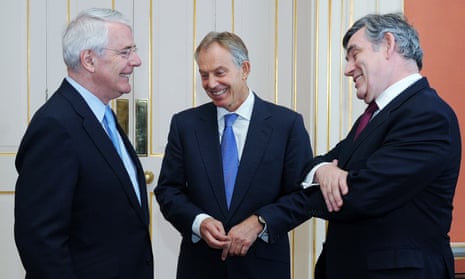If Tony Blair and David Cameron ever bump into each other, they can compare notes on the thanklessness of political parties. I wouldn’t be surprised if the words “ungrateful bastards” passed their lips. Mr Blair won his lot three consecutive elections, a feat never before achieved by Labour and a record that does not look likely to be repeated. Yet denouncing him is today the most reliable way to rouse a cheer from many leftwing audiences. Mr Cameron took the Tories back to power after a 13-year absence from office and then, at the last election, increased their seats and share of vote. Yet his successor in No 10 thinks her quickest route to popularity is to dump on him. I can see why he has decided not to hang around in parliament to be a spectator while Mrs May buries him alive.
The experience of these two ex-leaders tells the story of the rise and fall of a political era. Call it, if you like, the Age of Centrism. Or, if you prefer, the Liberal Ascendancy. It began in 1990 when John Major replaced Margaret Thatcher on a mission to revive the Tories’ popularity by softening her harsher ideological edges. Liberal centrism peaked under Tony Blair, endured through Gordon Brown and had a further lease of life during the coalition when Nick Clegg, and others who actually called themselves Liberal, joined the government. Many of its adherents think its last rites were read when Britain voted for Brexit.
I am, I know, painting with an extremely broad brush. There were serious differences between these men and their governments, but on the big issues there was common ground. All of them presided over a mixed economy of state and private provision of goods and services. All were committed to free trade; all were permissive on social issues. All subscribed to membership of the European Union. John Major and Tony Blair had a lot more in common with each other than either did with Nigel Farage or Jeremy Corbyn. Ditto Gordon Brown and David Cameron. New Labour accepted much of the Thatcherite economic settlement inherited from the Conservatives, which is precisely what was wrong with it for opponents from the left. Cameroonians embraced the social liberalism of the Blair era, much to the discontent of many on the traditional right.
Is centrism now discredited and defeated? To many observers, it looks that way. A recent collaboration between the Social Market Foundation and the pollsters Opinium is entitled “Dead Centre” and remarks “after a long referendum campaign focused on sovereignty and immigration, the Leave vote, the demise of Cameron’s political project, the failure of the Liberal Democrats to mount much of a comeback and the resilience of Corbynism and Scottish nationalism, the centre looks barren”.
Whatever anyone thinks of Jeremy Corbyn, no one would ever call him centrist. On Saturday, he will be re-elected as Labour leader. His team radiate confidence that he will win and win well. Supporters of his challenger, Owen Smith, sound resigned to defeat. That result will not be reflective of the wishes of Labour MPs who triggered the challenge when 172 of them declared they had no confidence in his leadership. Nor will it be a result that pays heed to the party’s dire poll ratings.
What it will show is how the Labour party has been transformed. There are all sorts of complicated reasons why Mr Corbyn will win. Then there is the straightforward explanation: the Labour electorate has become a lot more leftwing. Its membership began to shift left under Ed Miliband, moved further that way after the 2015 defeat and this process has accelerated over the past 12 months. There is evidence that Mr Smith has done well among people who were party members before 2015, but the gains he has made among that group have been matched – more than matched, most likely – by the support for Mr Corbyn from those who joined the party since he became leader. The chasm between a broadly centrist parliamentary party and a much more leftwing membership has grown even wider.
Over on the Conservative side of the ledger, people are still trying to get a precise ideological fix on Mrs May. She has revived the cabinet career of Liam Fox, a hardline Brexiter, but she has also promoted One Nation Tories such as Damian Green and David Lidington. She has made noises about corporate governance which sound leftwing coming from a Tory prime minister while indicating right in other policy areas. The ingredient that is bound to be the strongest flavour in the character of her government is withdrawal from the EU, bringing to fruition the dream of the Tory right.
Between a Brexiteering Conservative government and Corbynista Labour, there are acres of unoccupied political real estate. This looks like an opportunity for the Lib Dems, who have historically prospered when the two major parties have moved off the centre. The Lib Dems have begun their conference in Brighton by boasting that they’ve been putting on members, but their poll rating is stuck at a level no better than their vote share at the last election. Memories of the coalition are too fresh for them to revive their pre-2010 role as a vehicle for protest. Their leader, Tim Farron, occasionally casts come-hither glances at Labour MPs, but they don’t see the Lib Dems as a place of refuge. Mr Farron and his small parliamentary band are struggling to make themselves heard. “You can only do so much with eight MPs,” laments one of them.
Their former leader, Nick Clegg, gamely speculates that politics has become so volatile and Brexit will be such a horrendous mess that the Lib Dems could be back in office sooner than anyone thinks as part of a “Government of National Unity”. His optimism is endearing but not widely shared. Most think that the road back for the Lib Dems will be the slow and hard one of gradually rebuilding their base in local government while hoping for a parliamentary byelection sensation here or there. One senior figure in the party describes it as “the work of a generation”. Paddy Ashdown has concluded that the party he used to lead isn’t capable of resurrecting liberal centrism by itself. So he has founded a campaign group called More United which hopes to recruit support from across parties.
Before there can be a revival, advocates of liberal centrism first have to work out why and where it went wrong. One way of thinking is that it was undone by the mistakes of individuals. Tony Blair’s reputation never recovered from the Iraq war. David Cameron blundered into Brexit. Nick Clegg failed to tell a persuasive story about the coalition government and his role in it.
A less comfortable explanation for liberal centrists is that there were some fundamental flaws in their creed and how they applied it in power. They won elections by promising to be best at delivering prosperity combined with social justice, a formula which broke down when economic times got rough and nasty choices had to be made.
Liberal centrists have been guilty of hubris. One of their shared assumptions was that free trade was always a good thing, which meant that globalisation would be wonderful for everyone and, even if it wasn’t, it was too powerful to be resisted. Tony Blair didn’t forsee the blowback against a permissive immigration policy and nor did his counterparts across the EU. David Cameron tried to exploit discontent about immigration but only made it worse by making promises to curb labour flows that he couldn’t keep.
They blithely assumed that their cosmopolitan, internationalist, tolerant instincts were so obviously correct, so patently rational, that they had to prevail. They couldn’t believe Britain would vote to leave the EU – and are still struggling to come to terms with a referendum result that rejected their entire world view. They largely became defenders of the status quo – and that status quo was widely held to favour elites – in a period of rising rage against anything that could be construed as the “establishment”. That created a fertile climate for insurgents preaching left, right and nationalist populisms. The centrists were slow to spot and respond to the rise of identity politics, whether it came in the guise of Ukip or the form of the Scottish nationalists. These insurgent forces sounded authentic and passionate where centrists too often came over as bloodless and manageralist. It may be of some consolation, but that is all it is, that this has happened to the traditional governing parties of the centre-right and centre-left across the developed democracies.
Centrist leaders were adept at winning elections in their era of dominance but never so good at enthusing supporters who chafed at the compromises involved. One of the things Mr Corbyn indisputably represents is a backlash against Blairism. Mrs May is probably right to calculate that her party never felt all that warm towards Mr Cameron.
And yet. Liberal centrism prospered because it was attractive to a critical mass of voters. They liked governments that sounded moderate, acted pragmatically and weren’t too heavy with ideology. Many voters still want that. When asked to place themselves on the political spectrum, nearly half of the electorate still self-identifies with the centre.
The centre is not dead. It is dazed and confused. It needs fresh ideas and more engaging ways of expressing itself. It will get its voice back one day.

